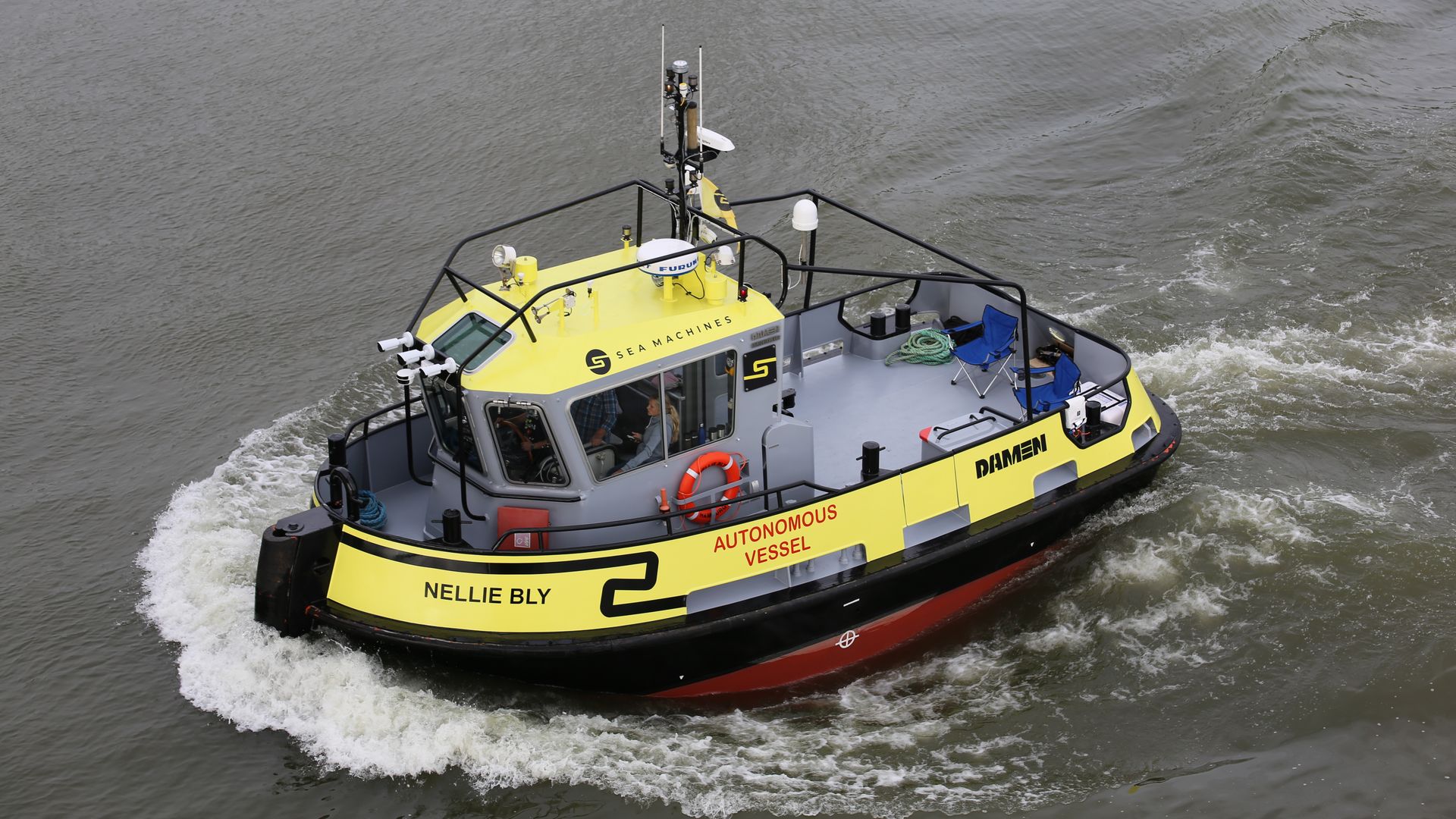| | | | | | | Presented By Google Cloud | | | | Axios What's Next | | By Jennifer A. Kingson, Joann Muller and Erica Pandey ·Oct 13, 2021 | | Most tugboats still operate the way they did a generation or two ago, but advances in autonomous navigation technology are poised to upend that model, Jennifer A. Kingson writes. - Today's What's Next reader photo comes from Greg Moss of Waterford, Michigan, who took it during an Alaska vacation.
- We need your photos, please! Tell us what's on your camera roll that captures the way we'll live, work and play in the near future: whatsnext@axios.com.
🪐 We're launching our latest Get Smart video short course series on space. Sign up here and get it today. Today's Smart Brevity count: 1,228 words ... 4.5 minutes. | | | | | | 1 big thing: Maiden voyage of the first long-haul automated tugboat |  | | | The Nellie Bly, a standard 36-foot tugboat that's been equipped to operate autonomously. Photo: Arie Boer/Sea Machines Robotics | | | | The Nellie Bly is currently about three-quarters of the way through its mission: To become the first autonomously operated tugboat to complete a long-haul run, Jennifer A Kingson writes. Why it matters: While many tugs are already using autonomous technology for short ship-to-shore runs, it would be much cheaper and easier for long-haul vessels — like oil tankers, container ships and ocean-floor survey boats — to use autonomous tugs as their scouts. Driving the news: A Boston-based company called Sea Machines Robotics — a pioneer in autonomous tug technology — has outfitted a 36-foot tugboat called the Nellie Bly with the self-driving equipment it needs to circumnavigate Denmark, a voyage of more than 1,000 nautical miles (about 1,150 regular miles). - The Nellie Bly left on Sept. 30 and is expected to arrive at its destination on Oct. 16. (Fans can follow its progress on a dashboard that includes a live stream when the boat is in motion.)
- A normal tugboat would have a rotation of people with hands on the wheel at all times. The Nellie Bly has only two people on board — for "safety and redundancy" — while a team from a control room in Boston keeps the boat on course.
- So far, "we've been able to operate 90% autonomously," Amelia Smith, a spokeswoman for Sea Machines Robotics, tells Axios. "There've been periods of time when there have been people involved [in controlling the vessel], and that's OK."
- The Nellie Bly — which is pushing a barge from Rotterdam, Netherlands, to Hamburg, Germany — has already avoided 117 obstacles that could have been potential collisions.
The big picture: The ability to rely on computer-run tugs for long-haul sea voyages is "going to make the industry more productive" and "put a lot more vessels on water," Michael G. Johnson, CEO of Sea Machine Robotics, tells Axios. - Autonomous tugs could make a big difference to vessels that clean up oil spills, survey the ocean floor for wind farms, and transport cargo around the world (like the ones that are currently piling up at U.S. ports).
- "We are proving that we can command that same journey through a remote commander, somebody that's not on the tug itself," Johnson said. "Our goal is that 99% of the continuous control effort is being managed by the autonomy system."
The bottom line: Tides, water currents and the lack of marked lanes make autonomous driving a lot different in the water than on pavement, but the development of computer-controlled boating is happening at the same rapid pace that automakers are pursuing automated vehicles. Read the full story. |     | | | | | | 2. Almost 15% of high-paying job listings are now remote |  Reproduced from Ladders Inc.; Note: Data includes jobs with annual salaries of $80,000 or more; Chart: Axios Visuals More and more jobs that can be done from your bedroom are showing up on the high-paying end of the help-wanted spectrum, according to research by Ladders Inc., a job search site, Jennifer writes. Why it matters: There's the potential for greater work-life balance for executives and others in the high-earning realm — and there's more hope of the same for people who aspire to that echelon. Driving the news: Ladders — which specializes in jobs that pay more than $100,000 annually but included jobs of $80,000 or more in this research — said remote jobs rose to 14.67% of all high-paying listings in the U.S. and Canada in Q3 2021, up from 12.80% in Q2 2021. - The number was 3.69% in the pre-pandemic days of Q4 2019.
- There are now more than 30,000 high-paying remote jobs available in the U.S. and Canada, according to Ladders.
Details: Some industries added eye-popping increases in the percentage of high-paying remote jobs. These figures were from the first nine months of 2021: - Finance and insurance: 2,062%
- Legal and accounting: 1,995%
- Retail and consumer goods: 1,651%
- Aerospace: 1,341%
- Media: 1,280%
What they're saying: "The commute from your bedroom is here to stay," Marc Cenedella, CEO of Ladders, said in a statement. "This is not a fad." Share this story. |     | | | | | | 3. Our watery future: Gauging the threat from rising seas |  | | | Still images from an interactive slider comparing Washington Nationals Stadium's future with steep emissions cuts with our current carbon path. Courtesy: Climate Central | | | | Nations' follow through — or lack thereof — on pledges made at the looming UN climate summit (known as COP 26) will help determine the long-term fate of tens of millions of people living in coastal megacities threatened by rising seas, writes Andrew Freedman of Axios Generate. Why it matters: The delayed response of the climate system, with seas that warm slowly and ice sheets that can take centuries to reach equilibrium — long after air temperatures have leveled off, raises the stakes for COP26 and government decisions in coming years. - Cumulative carbon emissions have already committed the world to about 6.2 feet of sea-level rise over the next few centuries, even if emissions suddenly ceased today, the study finds.
- The study makes clear U.S. cities will need to find ways to cope with ever-increasing coastal inundation and may have to build new, never before tried infrastructure to save certain neighborhoods.
Driving the news: The new study was published Monday in Environmental Research Letters and visualized in startlingly detailed maps and simulations Tuesday by Climate Central, a climate research group. - The study shows that if the world warms by about 3°C, as it's currently on course to do based on the trajectory of emissions, sea levels would eventually imperil about 15% of the current global population, or about 1 billion people.
- If, on the other hand, the world were to meet the temperature targets laid out by the Paris Climate Agreement, and hold warming to well below 2°C (3.6°F) relative to preindustrial levels, that number could be cut in half, the study found.
Between the lines: The greatest vulnerability to sea-level rise during this century and beyond is in Asia, where 8 out of the top 10 most at-risk large nations are located. The bottom line: The seas will continue rising long after emissions are cut. How high they go depends on our near-term actions. Read the full story. |     | | | | | | A message from Google Cloud | | Explore what's now and what's next at Google Cloud Next | | |  | | | | From live Q&As with experts to hands-on demos and real-world applications of the latest Google Cloud tech, explore the possibilities at Next '21. Get informed, be inspired and expand your expertise. Register now to build a customized experience. | | | | | | 4. The health care worker revolt |  | | | Illustration: Shoshana Gordon/Axios | | | | The toll of the coronavirus pandemic has spurred nurses, front-line technicians and other hospital employees to walk out or authorize strikes, Bob Herman writes in Axios Vitals. Why it matters: The pandemic has buckled a system that already faced worker shortages and burnout. Patients ultimately can't receive adequate care if workers leave from the stress and violence. Driving the news: Unions representing more than 24,000 nurses and other hospital workers yesterday authorized strikes at Kaiser Permanente facilities in California and Oregon. - A strike authorization does not automatically trigger a strike. Unions still have to provide hospitals with a 10-day notice before walking out.
- Kaiser Permanente proposed 1% annual pay raises over the next three years and a two-tier wage system, but unions want 4% annual pay raises and no two-tier system.
What they're saying: "We're drowning. There's just not enough staff," Jennifer Stone, a unionized ER technician at Sutter Delta Medical Center in California, said in a press release this month. "We're talking down angry COVID patients, then we're rushing to a code. ... We can't do it all anymore." Share this story. |     | | | | | | 5. Reader photo of the day |  | | | Photo: Greg Moss | | | | What's Next: Bear-proof latches Greg Moss of Waterford, Michigan, writes: "In Sitka, Alaska, there are bins for plastic, bins for cans and bins for paper. Now, there's one for pedestrians — and it has a bear-proof latch! "The sign is intended for the walkway along the water. The bear-proof latch is on the front of the bin. To get into the bin, there is a diagram to put your hand up inside the cover." |     | | | | | | A message from Google Cloud | | Looking for your next cloud insights? Join Google Cloud Next | | |  | | | | Join Next '21 to experience live Q&As with leading experts and hands-on demos with the latest Google Cloud tech. This no-cost digital event lets you explore new possibilities, get informed, be inspired, and expand your expertise. Register now. | | | | Please stay calm if you encounter a bear, the National Park Service advises! And, when you're home telling friends about what happened, feel free to recommend that they sign up for Axios What's Next. |  | | It'll help you deliver employee communications more effectively. | | | | | | Axios thanks our partners for supporting our newsletters. If you're interested in advertising, learn more here.
Sponsorship has no influence on editorial content. Axios, 3100 Clarendon Blvd, Suite 1300, Arlington VA 22201 | | | You received this email because you signed up for newsletters from Axios.
Change your preferences or unsubscribe here. | | | Was this email forwarded to you?
Sign up now to get Axios in your inbox. | | | | Follow Axios on social media:    | | | | | |










No comments:
Post a Comment